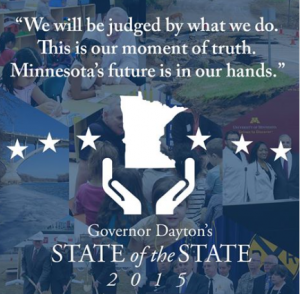CONTRIBUTE! VOLUNTEER! CONTACT US!
Grow with Us Plant Sale!
Get all of your garden needs and help support DFL48! This year, we’re offering you plant cards at both Gerten’s Greenhouses and Garden Center in Inver Grove Heights and Wagner’s Greenhouse in Minneapolis and Bloomington.
Tweets by @DFL48
TAG | higher education
by Lt. Gov. Tina Smith (original appears in the May 11, 2015, issue of the StarTribune
 Until the 1940s, Minnesota was a relatively poor state. Today, we rank among the wealthiest in the country — home to the most Fortune 500 companies per capita and an above-average per capita income. This generational transformation did not happen by accident. Through the foresight of leaders who recognized the importance of higher education, initiatives like the GI Bill, Pell grant program, and state grant program in the 1950s, ’60s and ’70s made college affordable to an entire generation of young Minnesotans.
Until the 1940s, Minnesota was a relatively poor state. Today, we rank among the wealthiest in the country — home to the most Fortune 500 companies per capita and an above-average per capita income. This generational transformation did not happen by accident. Through the foresight of leaders who recognized the importance of higher education, initiatives like the GI Bill, Pell grant program, and state grant program in the 1950s, ’60s and ’70s made college affordable to an entire generation of young Minnesotans.
In the 1980s, Gov. Rudy Perpich declared Minnesota the “Brainpower State” — and rightly so. Minnesota has one of the best-educated workforces in the country, and is home to a diverse and growing economy anchored by agricultural and food products, mining and manufacturing, finance and banking, and medical products and research. (more…)
30
Invest in Minnesota’s Future
Posted by SD48 DFL Communications Team in Letters to the Editor, News
A highly educated work force is Minnesota’s number one resource. It is essential that we continue to invest in our colleges and universities to keep them the best in the country. Second-best colleges turn out mediocre graduates. And meanwhile, our most talented students will go to other states for their education.
Please urge our legislators not to short change the students. Last year on the recommendation of Gov. Dayton, the Legislature passed legislation to freeze tuition in Minnesota’s colleges and universities. Yearly tuition hikes had pushed the cost of higher education beyond the means of many sutdents. This year the Legislature is recommending that the tuition freeze only apply to two-year institutions. Students who need to attend four-year colleges will again face escalating tuition. Most of these students will graduate with devastating debts. It’s not fair!
Businesses will leave our state without an educated workforce. Cutting funds for higher education is shortsighted indeed. Keeping tution reasonable is also important. We need all students who desire to attend college to be able to afford it, and not to end up at graduation with enormous debts either. We must keep the tuition freeze for all state colleges and universities.
Remind our legislators today to make Minnesota’s colleges and universities a top priority in the budget.
Donna Murphy
Eden Prairie
Eden Prairie News, April 30, 2015
29
Rep. Selcer’s April 28, 2015 Update
Posted by SD48 DFL Communications Team in Issues, News, Our Candidates & Elected Officials
|
We have been hearing many budget bills on the House floor recently, and will continue to pass pieces of the budget this week. I want to provide you with a brief update of each piece of legislation. E-12 Education With a $2 billion surplus, investing in education should be one of our top priorities. Unfortunately, the House majority has brought forward an education budget that increasing education funding by less than a 1 percent. We have heard from districts across the metro that class sizes will grow and teachers will be laid off as a result. I spoke about this issue Saturday on the House floor, when the bill was passed. To watch my speech and hear more, click here: https://www.youtube.com/watch?v=COlcg_BRHKw. Civic and business leaders agree that Minnesota is a great place to live and work because we have one the best educational systems. But it won’t stay that way if we can’t provide schools funding at times when the economy is strong, especially after years of cuts and budget shifts. It is my hope that a more reasonable and sustainable proposal comes back from conference committee. I am happy to report that there are some good provisions in the education bill, such as increased investment in early childhood education and concurrent enrollment opportunities for our high school students so they can earn post-secondary credits while in high school. Hopefully we can build on these bipartisan investments in conference committee. Public Safety The legislature was able to work productively this session in the area of public safety and crime prevention. The resulting bill includes $250,000 to combat terrorism in Minnesota, stemming from the recent ISIL recruit arrests. The bill also includes additional resources to combat human trafficking and child abuse. I supported this bipartisan bill. State Government Finance The state government bill was passed on Friday, which unfortunately shifts millions out of pension funds, creates unfunded burdens and eliminates limits on campaign spending and contributions from PACs and lobbyists. This provision is especially troubling to me, as I believe we need more disclosure and less outside spending in our elections. Environment & Natural Resources On Friday, we also passed the environment and natural resources bill. I voted against this proposal because I felt that it threatened Minnesota’s clean water and breathable air, as well as the accounting shifts and gimmicks included. The environment bill shifts nearly $60 million out of the fund we use to clean up closed landfills, takes money from the school trust, and gives up on fighting aquatic invasive species by cutting millions from prevention efforts. I have concerns about the funding shifts in this bill and the troubling trend of this accounting in the House majority’s budget. Higher Education Monday, the House passed the higher education on a nearly party line vote. This bill reverses the tuition freeze currently in place for all Minnesota students at public colleges and universities and will increase the costs of higher education for students and parents. There is absolutely no funding included to help our University of MN students with skyrocketing tuition. With a budget surplus, I think we should prioritize student debt and tuition relief for students and their families. Transportation Unfortunately, the transportation bill raids some funds the Minnesota Department of Transportation holds in reserves for emergencies, such as harsh winters or natural disasters. There is also a great deal of shifting of funds and borrowing used to fund various transportation needs. We need to have a serious discussion about which additional funding streams we may want to dedicate out of the general fund to transportation, and how we will handle that additional strain on the general fund, which funds education and health care, during the next inevitable economic downturn. I have serious concerns with this funding and voted against the proposal. Jobs & Energy Last Thursday, the jobs and energy bill was passed. Provisions within the bill will stop us from repaying loans we took out under Governor Pawlenty. We should be using our budget surplus to invest and ensure sound budgeting into the future. I voted against this proposal. Health & Human Services The health and human services bill will cut state health funding by $1.152 billion and eliminate MinnesotaCare, which will cause 100,000 low-income, working Minnesotans to lose their health insurance. The bill includes many accounting shifts and gimmicks, including $300 million in savings that our House nonpartisan research staff has said will only amount to an estimated $17 million. For these reasons, I voted against the bill. I voted against many of these budget bills due to insufficient, unstable funding and budgetary tricks and gimmicks. With a surplus, we should be making strategic investments to ensure a prosperous economic future for businesses and families. While there were some good provisions in these pieces of legislation, I am hopeful that the final budget proposal includes more balance and sound budgeting and will garner bipartisan support. As always, please contact me anytime with your input. I can be reached by phone at (651) 296-3964 or by email at . Thank you for the honor of representing you at the State Capitol. Best, Yvonne Selcer |
E-12 education · environment and natural resources · HD48A · health and human services · higher education · House District 48A · jobs and energy · Public Safety · Rep. Selcer · state government finance · transportation · Yvonne Selcer
 Gov. Mark Dayton has introduced a Jobs Bill that would invest $842 million in infrastructure projects statewide, creating more than 23,900 Minnesota jobs. This new Jobs Bill would help addresses many of the state’s critical infrastructure needs, while strengthening Minnesota’s economy and putting thousands of people to work.
Gov. Mark Dayton has introduced a Jobs Bill that would invest $842 million in infrastructure projects statewide, creating more than 23,900 Minnesota jobs. This new Jobs Bill would help addresses many of the state’s critical infrastructure needs, while strengthening Minnesota’s economy and putting thousands of people to work.
“My proposals would put thousands of Minnesotans to work throughout our state,” said Gov. Dayton. “This bill gives priority to projects that have been delayed for years and are crucial to modernizing MnSCU and U of M buildings and classrooms, and improving local infrastructure. I ask the Legislature to join me in working to pass a Jobs Bill this session to boost Minnesota’s economy and address our state’s most crucial infrastructure needs.”
The Governor’s Jobs Bill includes critical infrastructure projects distributed all across Minnesota. The bill balances the needs of the state, with 43 percent of the projects are in Greater Minnesota, 38 percent in the Twin Cities Area, and 19 percent of the projects with statewide impacts. Gov. Dayton’ Jobs Bill also is designed to make state resources go farther, by leveraging more than $420 million in private, local, and federal dollars.
Statewide economic development
The Governor’s Jobs Bill supports regional centers statewide – investing in projects that will create jobs, attract additional private investment, and support economic development in communities across Minnesota. Some of those investments include:
- Lewis & Clark Water System – Gov. Dayton’s Jobs Bill would invest $48 million in the Lewis & Clark System to deliver water to City of Magnolia, Lincoln-Pipestone Regional Water, and City of Worthington to meet growing needs of businesses and residents. This funding would complete the project and deliver water to more than 20,000 Minnesotans.
- Port improvements – The Governor’s proposal would provide $10 million to make navigation improvements and other enhancements at the ports of St. Paul, Winona, Red Wing, and Duluth to promote regional economic development.
- Litchfield power generation – To meet the growing needs of Litchfield area businesses, Gov. Dayton’s Jobs Bill would provide $5 million for the design and construction of power generation improvements.
flood mitigation and dam improvements · Gov. Dayton · higher education · Mark Dayton · preserving Minnesota's treasures · rail and pipeline safety · statewide economic development · Workforce housing and homelessness
10
Gov. Dayton’s 2015 State of the State Address
Posted by SD48 DFL Communications Team in Gov. Mark Dayton, Issues, News, Our Candidates & Elected Officials
2015 Budget for a Better Minnesota
 Last night, Governor Mark Dayton outlined his vision for Minnesota’s future – highlighting his proposals for preK-12 education, higher education affordability, and transportation. What did we learn?
Last night, Governor Mark Dayton outlined his vision for Minnesota’s future – highlighting his proposals for preK-12 education, higher education affordability, and transportation. What did we learn?
Now is the time to act. This year, we have the rare opportunity to lay the foundation for Minnesota’s future.
For more than a decade, Minnesota was saddled by chronic deficits – burdened by shifts, gimmicks, and deep cuts. But during the past few years, Governor Dayton has worked to clean up the state’s fiscal mess, turn deep deficits into surpluses, and position Minnesota for future success.
- A Balanced Budget – When Governor Dayton took office in 2011, our state faced a $6.1 billion deficit. Thanks to Minnesota workers and businesses, and a Governor willing to make tough decisions, we have a nearly $2 billion surplus today.
- Building on Past Investments – During the last two years, the Governor and DFL Legislature made long-overdue investments in all-day Kindergarten, and paying back the shifts and gimmicks that hurt Minnesota schools and seniors.
- Laying the Foundation – Now with the Minnesota’s fiscal house in order, Governor Dayton believes we have a great opportunity this year to build on these investments and lay the foundation for an even better Minnesota.
2015 State of the State · balanced budget · comprehensive transportation solution · Gov. Dayton · higher education · Mark Dayton · universal pre-K
 DFL48
DFL48
